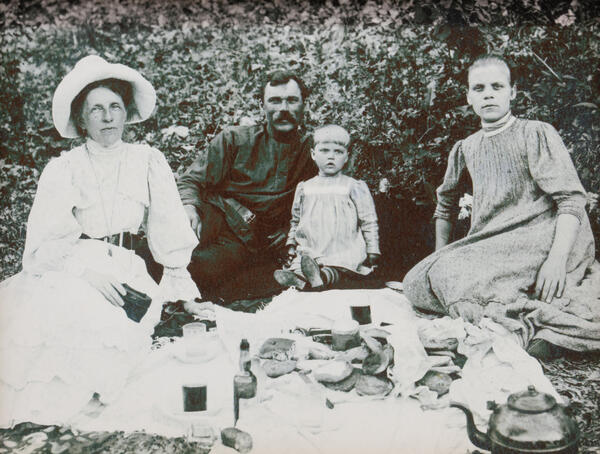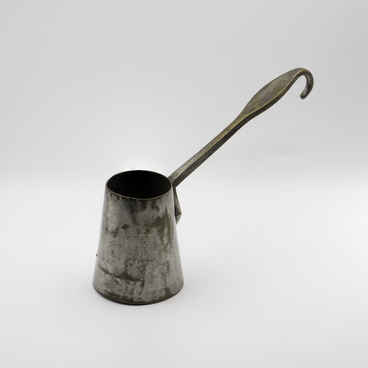For a long time, one of the favorite recreation places of Krasnoyarsk residents was the Krasnoyarsk City Garden, which was opened on the initiative of the first Yenisei governor Alexander Stepanov and was developed under the governor Vasily Padalka. At the end of the 19th century, Krasnoyarsk Pillars became a popular outing destination. It is one of the most famous nature reserves in Russia. The photo from the museum collection was taken there. When making preparations for a hike to the Pillars, families would take food, utensils, and necessary clothes with them. To get to the place, it was necessary to cross the Yenisei by boat or ferry, because there were no bridges at that time, and then to walk or ride a horse for a long while.
The photo shows relatives and friends of the famous Krasnoyarsk photographer and museum employee Ludvig Vonago spending their leisure time on the Pillars in 1910. The photo shows Elena Konstantinovna Pokrasso, Vonago’s wife, who played the piano and was a music teacher, with unknown people.
The tradition of large group photographs was developed by the 1870s. Most often people were photographed in pavilions. The first photo studio in Krasnoyarsk belonged to a Prussian citizen Heinrich Christianovich Keppel. He received permission to open his business in 1865. Later, such photographers as Mendel Axelrod, Joseph Lukhtansky, and August Nitram made a name for themselves. Ludwig Vonago was a representative of the next generation of Krasnoyarsk photographers — of the 1900s. He was the son of Jerzy Vonago, a Pole exiled to Siberia for his participation in the Polish Uprising of 1863-1864. Ludwig was born in 1872, as the researchers of his life suggest, in the city of Tomsk, where the photographer’s father was exiled. Later, the family moved to Minusinsk.
In 1902, Vonago was appointed a forester in the Yenisei district and moved to Krasnoyarsk. The first mention of him as a photographer is connected with the Krasnoyarsk Pillars. Vonago took pictures of rocks and various ways of climbing them, and in 1910 he decided to retire from the service and devote himself entirely to photography. As a photographer, Vonago was active in the 1900s — 1930s and managed to capture many significant events in the history of the city: the revolution of 1905, the destructive ice drift on the Yenisei River, city fires, and the everyday life of Krasnoyarsk.
During the First World War and Civil War Vonago and his wife lived in Kansk, and in 1919, he became an assistant record keeper of the Yenisei Governorate in the Kansk district. In 1934, shortly before his death, the photographer gave his collection of glass plate negatives to the Krasnoyarsk Museum of Local History.
The photo shows relatives and friends of the famous Krasnoyarsk photographer and museum employee Ludvig Vonago spending their leisure time on the Pillars in 1910. The photo shows Elena Konstantinovna Pokrasso, Vonago’s wife, who played the piano and was a music teacher, with unknown people.
The tradition of large group photographs was developed by the 1870s. Most often people were photographed in pavilions. The first photo studio in Krasnoyarsk belonged to a Prussian citizen Heinrich Christianovich Keppel. He received permission to open his business in 1865. Later, such photographers as Mendel Axelrod, Joseph Lukhtansky, and August Nitram made a name for themselves. Ludwig Vonago was a representative of the next generation of Krasnoyarsk photographers — of the 1900s. He was the son of Jerzy Vonago, a Pole exiled to Siberia for his participation in the Polish Uprising of 1863-1864. Ludwig was born in 1872, as the researchers of his life suggest, in the city of Tomsk, where the photographer’s father was exiled. Later, the family moved to Minusinsk.
In 1902, Vonago was appointed a forester in the Yenisei district and moved to Krasnoyarsk. The first mention of him as a photographer is connected with the Krasnoyarsk Pillars. Vonago took pictures of rocks and various ways of climbing them, and in 1910 he decided to retire from the service and devote himself entirely to photography. As a photographer, Vonago was active in the 1900s — 1930s and managed to capture many significant events in the history of the city: the revolution of 1905, the destructive ice drift on the Yenisei River, city fires, and the everyday life of Krasnoyarsk.
During the First World War and Civil War Vonago and his wife lived in Kansk, and in 1919, he became an assistant record keeper of the Yenisei Governorate in the Kansk district. In 1934, shortly before his death, the photographer gave his collection of glass plate negatives to the Krasnoyarsk Museum of Local History.



